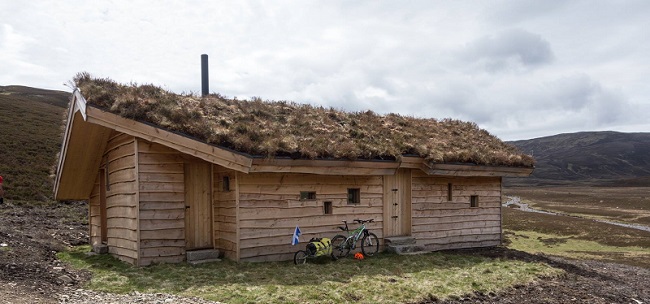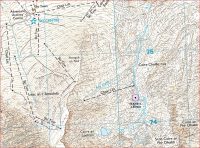IBSC Club Hut on North-East flank of Aonach MòrSummary: Inverness Backcountry Snowsports Club (see Appendix for more details) propose to build a mountain hut in a snow-holding corrie on Aonach Mòr. The hut would be built in line with the new Scottish Government guidance, provide sleeping space for 8-12 people, and feature a wood-stove for heating and gas for cooking. Waste disposal will be carried out to the highest standards.
|
|
|
Site: Grid ref NN202742, north of / adjacent to small lochan: http://tinyurl.com/IBSCHutLocation – Various sites were considered, but on balance it seems that the most suitable venue for such a hut would be the east side of Aonach Mòr, below and slightly to the North of Coire an Lochain (marked as a red, outlined spot on the above maps), for a number of reasons, but chiefly:
Benefits:
Users: In the first instance, it is proposed that the club hut be available for:
Legal and Planning: The Scottish Government has created a new class of building – “Huts and Bothies” which are to be constructed according to the new guidance being prepared with assistance from Reforesting Scotland. The hut would be constructed to the latest standards. Construction: The specifics of the hut to be eventually commissioned will depend largely on the new Scottish Government recreational huts guidance and planning guidelines. But even before the details are pinned down, the focus of the project will be on:
Proposed high-level design specifications: Initial considerations / proposals for design include: a) Gas hobs, for clean cooking in the hut;
Key Consultees: Reforesting Scotland, Scottish Avalanche Information Service, Scottish Natural Heritage, Scottish Environmental Protection Agency, The Highland Council, Mountaineering Scotland, Scottish Mountaineering Club, Lochaber Mountain Rescue Team, Police Scotland, John Muir Trust, local Mountain Guides – and any others as appropriate. We will shortly be sending out an email to key parties but in the meantime, please send your thoughts to secretary@ibsc.org.uk ___________________________________________________ APPENDIX 1: Club background: The Inverness Backcountry Snowsports Club emerged out of the club which was originally the Inverness Nordic Ski Club, and has a long history of running trips around the Highlands for enthusiasts of winter sports beyond the piste. As the normal snow-line through an average Highland winter has risen, opportunities for cross-country skiing from road / valley floor have diminished, but the club has broadened and adapted. With the improvements of diverse off-piste snowsports equipment (cheaper, lighter and more effective than previously), the club has evolved to include all different types of winter recreational activities, including ski-touring, skimountaineering, telemark-skiing, cross-country skiing, snow-kiting, igloo-camping and splitboarding. Over the past 5 years, the club has had somewhat of a renaissance, with average annual membership climbing to 100+. The club’s calendar is full throughout the winter, with trips scheduled fortnightly. Overnight trips have proved peerless for building community out of those with different ideas/plans for winter days out, but a shared passion for wild, winter mountain spaces. Thus far, the club has visited bothies, used the CIC Hut under the North Face of Ben Nevis, stayed in stalking-lodges and camped with tents and full (heavy) winter gear. Wonderful experiences, but each has inherent challenges which restrict access to the sports / club to a hard-core, committed few. The club supports the objectives of the MBA, as well as supporting the CIC Hut, wild camping and is appreciative of the estates which have welcomed us. As the club member grows, interest in off-piste skiing grows and the scene develops, it is felt that a dedicated Club hut is a logical and desirable progression which will allow more people to enjoy the snow and wild spaces whilst being a good example of sympathetic and appropriate accommodation in the mountains. https://www.youtube.com/watch?v=_MXvJVup-40&feature=youtu.be IBSC HUT WORKING GROUP – Please support the Club in developing our hut
The success of this venture will depend on how well we, as a club, are able to work together and use the skills that our membership has. We intend to set up a dedicated working group which will take forward the hut proposals and to construction and final opening.
We invite you to volunteer your time for this exciting project. We are welcoming anyone with an interest in the project and in particular, those with skills in the following areas:
The specifics of the hut to be eventually commissioned will depend largely on the new Scottish Government recreational huts guidance, which has recently been released. But even before the details are pinned down, the focus of the project will be on: • Exceptional insulation, for ease of heating;
At this stage, two main strands of design are being considered: • A modular design, built as pre-produced parts, manufactured elsewhere in the Highlands, driven to the ski area, and helicoptered in, to be assembled over a few days at the site;
Proposed high-level design specifications: Initial considerations / proposals for design include: • Gas hobs, for clean cooking in the hut;
A more detail hut proposal document is being developed and will be available soon.
|
|

Hut on Invercauld Estate, grid reference NJ179008.




Leave A Comment
You must be logged in to post a comment.